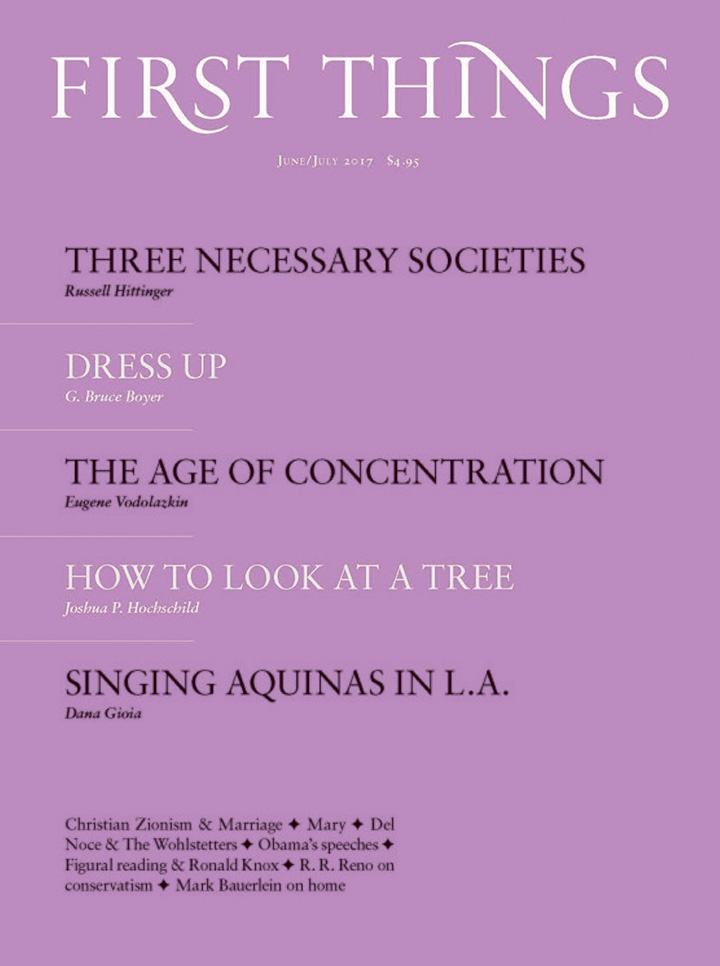When I was a child in parochial school, we began each morning with daily Mass. My mother worked nights, and no one in my family was an early riser. I inevitably arrived late to church. The nuns stared disapprovingly as I slipped in among my more punctual classmates in our assigned pews. This daily dose of shame was good training for later life. It made me immune to peer pressure.
The Mass, which was conducted entirely in Latin, meant little to me. I endured it respectfully as a mandatory exercise. I was relieved when the service ended and we filed off to our classrooms across the street. What impressed me was the church itself. St. Joseph’s was larger than the old Los Angeles cathedral. It was one of only two buildings in my hometown of Hawthorne, California, that might have been called beautiful. (The other was the Plaza, an old movie palace—now torn down.) I liked being inside St. Joseph’s lofty, cool interior, which was illuminated by tall stained-glass windows depicting the saints and apostles.
On the first Friday of each month, however, there was another ceremony called the Benediction. Having already attended Mass in the morning, we were marched into church again in the afternoon to participate in a short but elaborate ritual in honor of the Eucharist.
The priest, wearing a special mantle over his robes, entered accompanied by several altar boys. Candles were lit, and great suffocating clouds of incense dispersed. As the priest approached the altar, we sang a Latin hymn called O Salutaris Hostia. We read the verses from little laminated cards. I didn’t know what the words meant. (I assumed hostia meant the communion host, which, of course, it didn’t.) I liked singing the hymn, but it wasn’t my favorite.
American Catholics have a different sense of sacred music from Protestants. Singing is less central to our traditions of worship. The gap was especially wide before the Second Vatican Council. Catholics then rarely sang in church. There was no music at ordinary Mass, even on Sundays. Music was reserved for high Mass on special feast days, and then the singing was mostly Latin chant. In my Los Angeles parish, 1960 didn’t sound much different from 1660.
At Benediction, however, hymns played a central role. The music endowed the service with a sense of special occasion. Hearing St. Joseph’s mighty organ fill the capacious church gave me a physical thrill. It was the most powerful live music I had ever heard. Add to that titanic rumbling the voices of seven hundred parochial school kids singing in Latin, led by a dozen Sisters of Providence, and you will divine my wonderment and awe.
As the priest opened the shining tabernacle at the center of the marble altar and placed the consecrated host in a golden monstrance, we stood to sing a short hymn in veneration of the Eucharist. This hymn, the Tantum Ergo, has haunted me for the past sixty years. At each service I waited for it to begin, then sang in a blissful trance. It always ended too soon.
Here is the hymn. If you don’t know what the words mean, don’t worry; neither did I. Nor do I intend to translate them now. That is the point of the essay.
Tantum ergo Sacramentum
Veneremur cernui:
Et antiquum documentum
Novo cedat ritui:
Praestet fides supplementum
Sensuum defectui.
Genitori, Genitoque
Laus et jubilatio,
Salus, honor, virtus quoque
Sit et benedictio:
Procedenti ab utroque
Compar sit laudatio.
By third grade, I had the text indelibly memorized, though the only word I understood was sacramentum. The literal meaning of the words seemed unimportant compared to the experience of singing. Back then I felt no genuine attachment to what the sisters reverently referred to as “the Blessed Sacrament.” (That devotion came much later.) The Eucharist was mostly an abstract idea. I sensed a sanctity in which I could not participate. But as I stood singing this short hymn with all my friends and teachers, I physically felt enraptured and exhilarated in the act of veneration.
As an adult, I can’t accurately judge whether that experience was spiritual or aesthetic. I suspect that those two categories of perception are more interdependent than most people believe, especially in a child. I do know from my earliest memories that Tantum Ergo struck me as penetratingly sublime. Those two minutes of each month were more beautiful than anything outside the church doors on the ugly streets of my hometown. The hymn acquired private meaning—a web of deep longings and associations, of intellectual and spiritual awakenings that I didn’t yet understand.
I rarely received Communion, usually just at Christmas and Easter. We had been instructed only to receive the sacrament in “the state of grace.” In my convoluted young mind, I was a notorious sinner. Even before puberty, I always felt guilty about something.
Being different from other kids—dreamy, solitary, bookish—my mere existence felt vaguely culpable. Unless I dashed directly from the confessional to the communion rail, I would stumble back into perdition. So it wasn’t the Mass, which I attended listlessly six times a week, that brought me into the mysteries of faith; it was the infrequent Benedictions. Only there I momentarily lost my self-consciousness in joyful musical communion—singing ancient and enigmatic words in honor of an inexplicable transubstantiation.
In college I discovered that the intricately rhymed verses had been written by St. Thomas Aquinas for the new feast of Corpus Christi the year before Dante was born. The poem, therefore, dates to a specific moment in Western culture. It appeared just as Latin was about to give way to Italian as a literary language, and the Middle Ages were moving toward the Renaissance. That fact now seems significant to me.
Babel was my hometown. I was raised in thirteenth-century L.A. in a Spanish-speaking neighborhood by Italian immigrants and assimilated mestizos who worshipped in Latin in a city whose official language was English. Latin was not a dead language; it was simply the one reserved for sacred things—like singing—in a place full of competing dialects. Even as a child, I watched my family’s parlance change, as English superseded the languages of the older generation. No, the Tantum Ergo didn’t feel foreign. Old words brought over from an old world were my daily reality.
The old practices, as Aquinas noted, give way to new rites (Et antiquum documentum, / Novo cedat ritui). By the time I finished high school, Vatican II had dropped Latin from the Mass and most rituals. We still prayed in Latin, but now only in Latin class when we stood to recite a quick Pater Noster before digging into another forty lines of Virgil. At Mass we now sang folksy anthems composed by amateur Jesuit musicians. If hell has a hymnal, these tunes will fill its opening pages. Hardly anyone sang. The crowd at Sunday Mass grew smaller every year.
No one recognized the banality of the new liturgy as keenly as a California teenager. For me, aggiornamento became addio. After graduating from high school in 1969, I stopped going to Mass for nearly twenty years, except on Christmas and Easter with my mother. I never left the Church. I just stopped showing up. The hunger remained, unsatisfied. Finally, in middle age, I accepted the bad music as punishment for my sins and rejoined as a communicant.
Over the years I have learned that I was not the only kid deeply affected by the hymn. When the Tantum Ergo is mentioned to Catholics of my generation, often as not, somebody starts singing. I have watched that happen, even in bars. The words and tune arouse deep communal memories.
Aquinas’s hymn even ended up in my libretto for the opera Tony Caruso’s Final Broadcast. When I suggested employing the Tantum Ergo to the composer Paul Salerni, he immediately began singing the words over the phone. We ended up using the melody twice in the opera—once with the traditional words and tune, then later with the melody inverted to create a new chorale. A few years later, over lunch at the USC faculty club, I mentioned the hymn to the historian Kevin Starr. After singing the first stanza, he provided a theological exposition in his booming voice. “‘Praestet fides supplementum,’ Dana! ‘Faith provides a supplement for the defects of our senses!’” Conversation stopped at nearby tables. Yes, the hymn has an alarming effect on old Catholics.
My particular affection for the hymn probably originates in a combination of personal and impersonal factors. First, there was the resonant beauty of Aquinas’s verse set to the stately eighteenth-century tune by Samuel Webbe. Second, there was my personal experience of singing the words repeatedly for years with my friends in the first grand space I had ever seen. Finally, there was the mystery of the Eucharist, which I first understood not from theological instruction but through the beauty of song.
As an artist, I learned something else from the Latin hymns—that art is mysterious. It reaches us in ways we don’t fully understand. The literal sense of a song or a poem is only part of its meaning. Physical sound and rhythm exercise a power of enchantment that eludes paraphrase. Our intuition often outpaces our intellect, and music anticipates meaning. He who sings prays twice, sometimes unaware.
Dana Gioia is a poet and writer. He is currently Judge Widney Professor of Poetry and Public Culture at the University of Southern California.


